Stashing homegrown Zucchinis in the freezer after blanching is fine. But what if the plant freezes due to cold before harvesting? What will happen to the fruits and the plant?
Zucchinis enjoy hot weather to thrive. Zucchinis can tolerate cold temperatures up to 50°F. Below this range, it won’t last long. They thrive best at 60°F or above. So, you must protect them once the temperature reaches 45-50°F or goes below the range.
Frost damage in the Zucchini is awful. The best way out is protection. Are you stressed about how to prevent cold damage during freezing temperatures? This article can help you know how to grow the Zucchinis and protect them from cold damage.
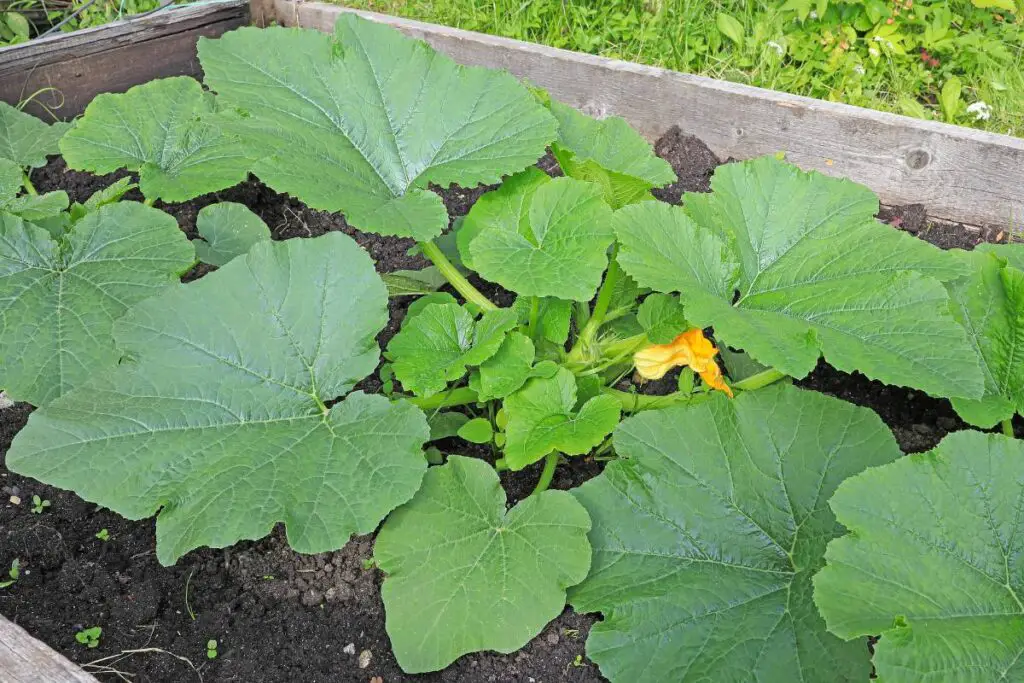
Understanding Frost and Freezing Temperatures
When the temperature goes below 50°F and stays within 32°F, that is a freezing temperature.
On the contrary, when the temperature crosses 32°F, the frost surfaces.
It will happen when the moisture in the air condenses and freezes over the surfaces like grass and plant leaves, Zucchini leaves in this case.
Once this happens, the frost will damage and rupture the plant cells.
Zucchini is a warm-weather lover and does not tolerate cold.
For them, the lowest temperature tolerance is 50°F.
Below this, they will receive cold damage.
However, some varieties can tolerate freezing temperatures below 50°F but will only last for a short time.
I am from Zone 7, and the lowest temperature for my region is between 0°F and 10°F.
But it also receives mild winters and long stretches of temperate and warm climates.
The warm weather in zones 6-7 continues for 6-7 months, which is more than enough for Zucchini growth.
The Zucchini will quickly mature by this time, and I usually finish my harvesting.
However, the temperatures in winter can drop too low.
If I am late, my Zucchinis might suffer from frost.
I faced it once, but after that, I always ensured starting seeds at the right time.
Zucchini’s Cold Tolerance
Zucchini is a summer squash, and it loves warm temperatures.
So, it is sensitive to cold and frosty weather.
The ideal temperature for Zucchini ranges between 70 to 75°F.
Zucchinis can tolerate temperatures up to 50°F at night, but not lower than that.
It is the lowest temperature they endure.
Once the temperature goes below 50°F for extended periods, Zucchini will start suffering from cold and become weak within no time.
While growing the Zucchinis in areas prone to frequent frost, it is essential to take preventive measures to save the plant from cold.
The best option is to grow them indoors in pots where you can control the temperature and prevent cold weather from reaching them.
Some cold-tolerant Zucchinis can endure temperatures below 50°F, too, up to 28-32°F, but not for extended periods.
Once the temperature drops to 32°F at night, your Zucchini will have damaged leaves, brown or wilted leaves, and may die over time.
You must protect your plants by covering them with frost covers or take them inside if they are potted.
Ideal Temperature Range for Zucchini
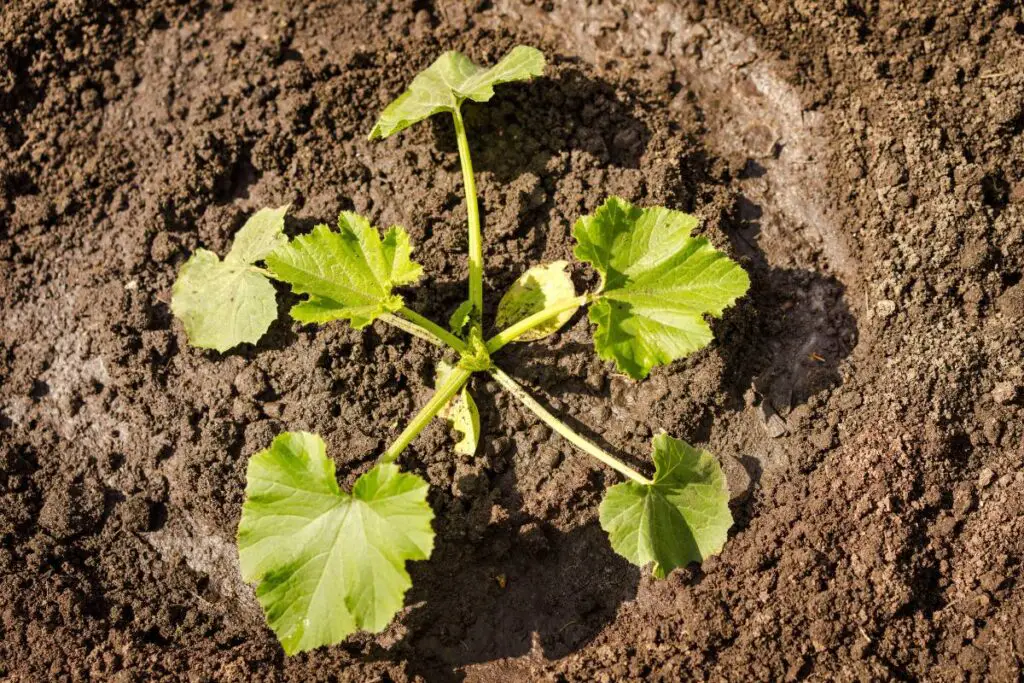
Zucchini plants thrive best in warm weather. They need a specific temperature for 2-3 months for adequate growth and fruit production.
The ideal temperature range for the Zucchini plants ranges between 70°F and 90°F.
At least 60-65°F is needed for optimal growth; higher than this will be great.
Within this range, the Zucchini plants will thrive, produce many leaves, and have abundant flowers and fruits.
Zucchinis can tolerate temperatures outside the range.
The lowest temperature is up to 50°F, and the highest should be around 95°F.
However, some variations are needed based on the growth stage of the plant:
- At the initial growth stages, Zucchinis will need an average warm temperature, neither too hot nor too cold. Cool temperatures delay germination, and hot temperatures can inhibit seed viability. At least 60°F is needed for seed germination.
- During the vegetative growth and flowering, Zucchinis should receive temperatures within 75-90°F. Temperatures above 90°F will reduce fruit production.
- During the fruit development, the ideal temperature is within 70°F. Temperatures above 90°Fw will affect the fruit growth, texture, and flavor.
Maintaining an ideal temperature is crucial for Zucchini growth.
It should neither be too hot nor too cold.
The best range is within 70-90°F.
Effects of Cold Stress on Zucchini Plants
When the Zucchini plants suffer from cold stress, it will show some signs, for example:
- Leaves become wilted and brown
- The leaves get covered by gray mold.
- The stems will become discolored.
- The flowers will fall off the plant.
- Reduced fruit production.
- In severe cases, the plant will die.
When the Zucchini plants receive frost, they can wilt, stop producing fruits, and then die after some time.
It happens when the night temperatures fall below 50°F for prolonged periods. It is tough to revive a plant with frost damage.
Frost protection after the cold damage will only be helpful if the damage level is less than 45-50%.
The damage will begin with brown and wilted leaves.
Over time, the frost will cover your plant and start affecting your plant’s health.
The stems will lose vigor and color, and the flowers will start falling off.
For this, there won’t be any pollination or fruit production.
Slowly, the plant will start dying.
If you want your plant to save from these effects, you must take preventive measures and protect your plant.
Protecting Zucchini from Cold Snaps
The Zucchinis will grow slowly when the temperature reaches 60°F or below in the winter.
Do not expect fast growth from them after the onset of the cold weather.
Most varieties depend on the pollinators for higher yields.
Cold weather reduces the activity of the pollinators.
If you plant late, pollination will rarely occur after a temperature drop.
If you have had enough fruits and do not see any fruit production further, you do not have to frost-proof them.
Zucchinis are annual plants and die after one growing season.
Once a plant produces around 3 to 9 pounds of fruits, it will stop producing.
So, spending your time and energy on frost-protecting such a plant is unnecessary.
So, when should you protect the Zucchinis? Here are two situations:
You have planted late; the autumn frost is upcoming, and your plant is yet to produce.
You have miscalculated the spring frost and planted the Zucchinis early.
Weather can be unpredictable. So, stay prepared to save your lovely plants.
Now the question is how to protect them from cold snaps and prevent frost damage.
Here are some proven methods to provide frost protection:
Use Row Covers or Frost Blankets For Insulation
You can use a cloth row cover, household blanket, plastic, newspaper, or frost cover or blanket over the Zucchinis during the freezing nighttime temperatures.
Make sure that the leaves do not touch the plastic.
It will significantly help if the temperature drops below 32°F but stays above 28°F.
Try using a heavier blanket so the freezing temperature cannot easily reach the plants.
You can buy a 10-by-30-foot rolls – Plant Covers Freeze Protection,10Ft x 30Ft Reusable Floating Row Cover,Freeze Protection Plant Blankets for Cold Weather (Support Hoops Not Included)
Avoid using the covers with hoops if your plant requires protection for a few nights.
Open the covers during the daytime when the sunlight strikes the Zucchini bed.
It will keep them warm and boost their growth.
The covers should not flap, touch the leaves, or hurt the plants.
Anchor the covers with heavy objects that stay unaffected by cold weather, for example, bricks.
Looking for gardening supplies? We have tested 100's of products before recommending them to you guys. Check out our best pick below:
| Image | Gardening Supplies | Best Price? |
|---|---|---|
 Top
Top Top
Top | Raised Garden Bed Kit | Check On Amazon |
 | XLUX Soil Moisture Meter, Plant Water Monitor, Soil Hygrometer Sensor for Gardening, Farming, Indoor and Outdoor Plants, No Batteries Required | No Results |
 Top
Top Top
Top | 82 Pcs Garden Tools Set and Extra Succulent Tools Set | Check On Amazon |
 | Joeys Garden Expandable Garden Hose with 8 Function Hose Nozzle, Lightweight Anti-Kink Flexible Garden Hoses, Extra Strength Fabric with Double Latex Core, (50 FT, Black) | No Results |
 Top
Top Top
Top | Dual Chamber Compost Tumbler | Check On Amazon |
 Top
Top Top
Top | Sunnyglade Plant Stakes | Check On Amazon |
 Top
Top Top
Top | Organic Cold Pressed Neem Seed Oil | Check On Amazon |
 Top
Top Top
Top | Mighty Mint Gallon :-Insect and Pest Control Peppermint Oil | Check On Amazon |
 Top
Top Top
Top | Scotts DiseaseEx Lawn Fungicide | Check On Amazon |
 Top
Top Top
Top | Jacks Classic 20-20-20 All Purpose Fertilizer | Check On Amazon |
 Top
Top Top
Top | 30,000 Seeds Pollinator Attracting Wildflower Mixture | Check On Amazon |
 Top
Top Top
Top | Survival Vegetable Seeds Garden Kit-Over 16,000 Seeds | Check On Amazon |
Mulching
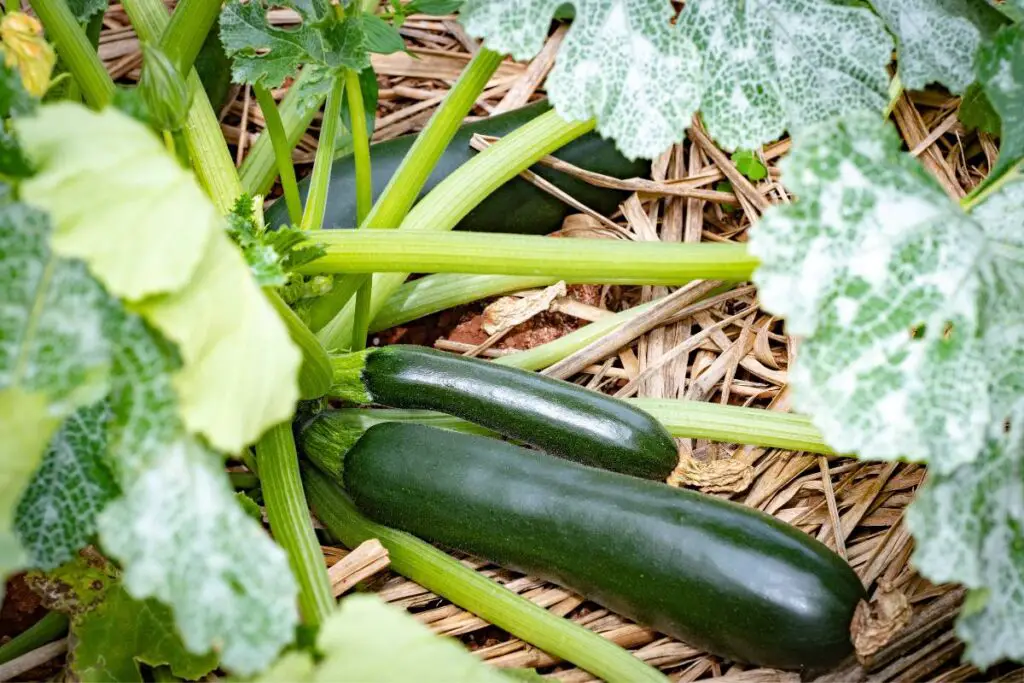
Mulching is a great way to protect your plants from cold and freezing temperatures.
Mulching can keep the soil warm and insulated and control the temperature.
It will help the plant stay alive throughout the cold weather.
Mulching helps create a protective barrier that stops the cold, freezing weather from reaching the roots.
Once the freezing weather reaches the roots, it becomes tough to revive the plant.
Mulching also reduces temperature fluctuations and conserves moisture in the soil.
This keeps the plant hydrated and in good shape.
Over time, the mulch will break down and add necessary nutrients to the soil, therefore boosting the plant’s overall growth and development.
Plant Zucchinis in raised beds
Cold can settle on the ground quickly.
Raised beds can provide better drainage and retain heat, benefiting the Zucchinis.
It creates a favorable microclimate for the Zucchini plants.
The elevation of soil temperatures in the raised beds will reduce the cold weather effect on the plants and keep them healthy throughout the freezing weather.
Take them inside
If you are growing the Zucchini plants in pots, you can take them inside.
Please keep them in a room with at least 60°F.
It will keep the plant healthy and promote good growth, development, and fruit production.
Ensure good watering and light.
Since it is winter, the Zucchini won’t require moisture like the summer months.
As for the lights, you can keep them near the south-facing window during the day. Or, use Grow lights.
Plant in a location where you can protect them
If you love to push the Zucchini’s growing season a bit by late planting, you would have to plant them at a place where you can protect them in the winter.
It also applies to the varieties with a longer growing season.
Find a place to put up row covers or frost blankets to protect them.
Monitor Weather Conditions
You need to keep monitoring the weather conditions.
Check the weather forecast of your region regularly and take action for your Zucchinis accordingly.
If the daytime stays warm, open the frost cover.
Again, when the temperature drops below 33°F at night, put back the covers.
Once the nighttime temperatures go above 55-60°F, there is no need to use frost covers.
Additional Preventive Measures For Frost Damage

There are a few preventive measures that can allow you to protect your Zucchini from frost damage.
Below are some of them:
Planting site or placement
- Avoid planting the Zucchinis in exposed areas with cold winds. Plant the Zucchinis where they can stay protected from the cold, for example, near other plants or structures.
- Avoid low spots, as these are areas where cold can settle quickly. Raised beds would be the best option.
- Plant the Zucchinis near the west or south-facing wall. These directions can receive enough sunlight during the day. The walls can absorb heat in the day and radiate at night, thus keeping the plants warm.
- You can also plant the Zucchinis around a boulder, shrub, or fence.
- Keep the potted plants close to each other in a sheltered spot close to your house.
Watering
Watering the plant can be beneficial.
The moisture you provide can hold heat better than the dry soil.
It will protect the plant roots from cold and keep the air near the plant warm.
Light
You can place a 100W lamp designed for outdoor use.
These lamps can emit enough warmth and keep your Zucchinis warm even at night when temperatures are below 50°F.
You can also use holiday lights. They are not LED lights.
Maintain 12 inches of distance between the lights and your plants.
Ensure that the lights do not come in contact with any material you use to protect the Zucchinis.
Spray anti-transpirant
You can spray some anti-transpirant on the Zucchini leaves or other cold-sensitive plants.
One coating of invisible polymer film from the spray can keep the Zucchini from frost damage for 3 months.
The spray can also trap moisture and keep the leaves hydrated.
You can try Wilt-Pruf® Concentrate, 1 Quart (.95 Liters).
Do not sow them outdoors
It is one of the best methods to protect your Zucchinis from frost, especially during the spring frost.
Sometimes, people miscalculate and sow the seeds outdoors, and after a few weeks, the area hits the spring’s last frost.
You can save your Zucchini from this unfortunate condition by sowing them indoors.
Start the seeds indoors, then transplant them when the warm spell hits your region.
Ensure that the soil temperature has risen above 60°F and the air temperature above 70°F.
Starting the seeds indoors also gives the Zucchinis an extended growth period.
Grow an early cultivar
If your region receives a very short growing season for Zucchini, grow cultivars that can mature early.
For example, a disease-resistant variety like Sunglo can mature around 38-40 days.
The Elite Zucchini variety can mature after 46 days.
Once the plant has given enough fruits before the frost and stopped producing, there is no need to protect the plant from any frost damage.
Consider potting the Zucchinis
When you plant the Zucchinis in pots, you can take them inside before the fall frost appears.
You can keep them inside and control their growing and environmental conditions, which is impossible outside.
This way, you can save your plants from frost damage, and you won’t have to protect them by row covers or mulching.
Recovering Damaged Zucchini Plants
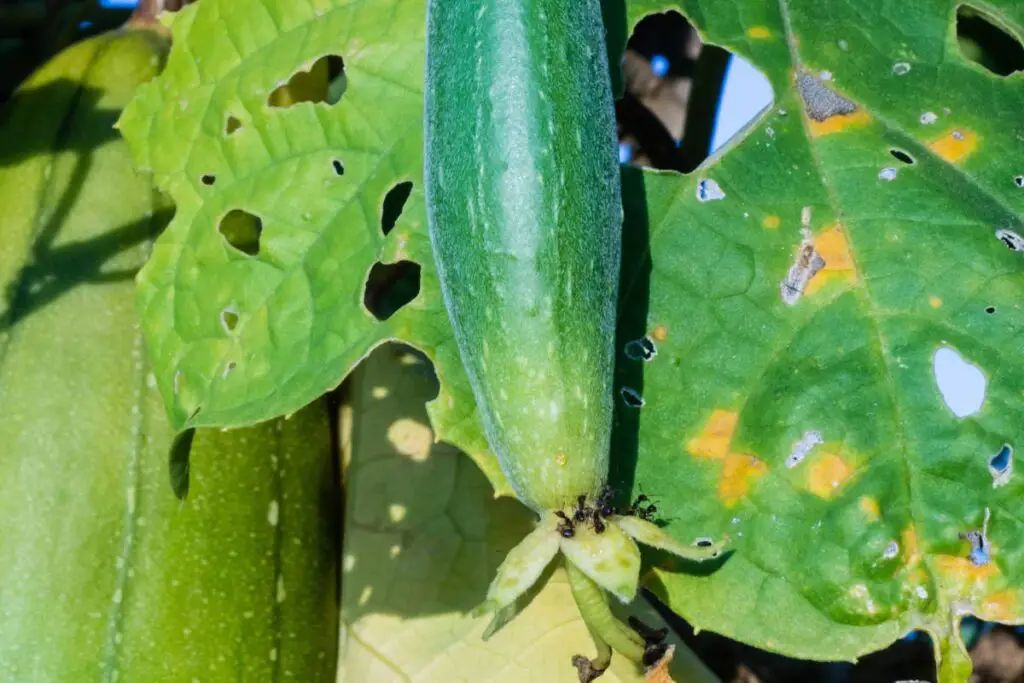
Recovering a Zucchini with cold damage can be difficult.
When the fruits get frost-bitten, the skin will become white.
You can still eat them by peeling off the skin, but I cannot guarantee anything about storage.
When the plant receives frost damage, it becomes quite challenging to revive.
Reviving a Zucchini plant with cold damage is only possible if the damage is below 40-50%. Otherwise, you cannot save it.
To recover the plant:
- Examine and check the amount of damage.
- Trim away the damaged parts of the plant and provide proper warmth and protection.
- Cover them with frost covers, and put up a 100W light close to them.
- Apply 1-2 inches thick layer of mulch.
- Ensure a consistently moist soil but not too wet. A damaged plant will suffer while absorbing the moisture. So, maintain consistency.
- Be patient and observe your plant’s behavior. If you see any new growth, continue caring for the plant.
- If there are no changes but only degradation, you must pull out this plant and start growing new plants.
Since I am from zone 7, Zucchinis receives an excellent growing season.
Though there are chances of spring or fall frost, I rarely struggled with this issue.
But one of my friends suggested these solutions if I ever need them.
Selecting Cold-Resistant Zucchini Varieties
Despite Zucchini’s intolerance to cold weather, you can still grow some of them in your garden.
Zucchinis are summer squashes; very few cultivars can tolerate cold weather below 50°F.
When Zucchinis stay unprotected at freezing temperatures, they will receive frost damage.
Even if you plant them at the right time, early fall frost or last spring frost can damage.
One way to grow the Zucchinis in cold weather is to grow the varieties with short growing seasons.
If you wait for the last spring frost to be over, you may be late and receive the fall frost before your plant has completed production.
If you are constrained by the number of frost-free days, get some varieties with shorter seasons and early maturers.
Here are some early maturing varieties with shorter seasons:
- Sunglo Zucchini: 38 to 40 days
- Eight Balls: 40 days
- Seneca: 42 days
- Green machine: 45 days
- Spineless perfection: 45 days
- Gold rush: 45 days
- Round Zucchini: 45 days
- Spineless Beauty: 46 days
- Dunja: 47 days
- Easy Pick Gold II: 48 days
- If you wish to grow some cold-tolerant Zucchinis:
- Raven Zucchini
- Costata Romanesco
- Long Green Zucchini
- Fordhook Zucchini
These variants will take around 50-55 days to mature.
Though they take more days than the early cultivars, they can tolerate cold below 50°F.
Along with tolerating cold weather, these cultivars will also have higher yields.
However, it is still recommended to provide frost protection.
Harvesting Zucchini Before Frost
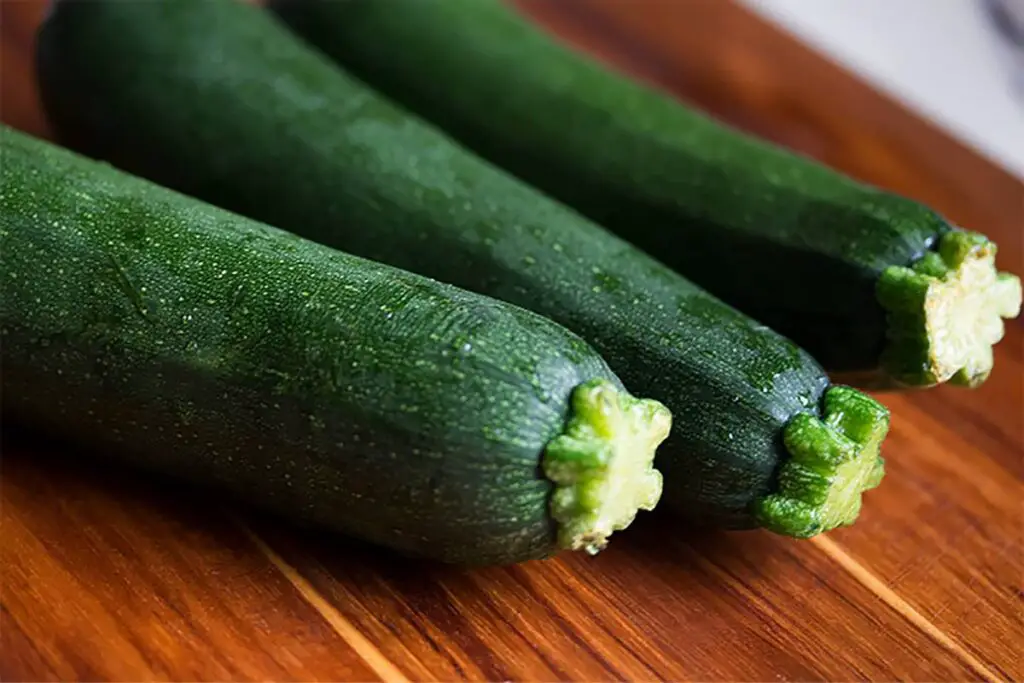
The rule is to harvest the Zucchinis when they have reached 6-8 inches tall and 2 inches in diameter.
It would also be better to pick them all before the frost hits your region.
Consider growing the early cultivars if you live in a colder zone with short growing seasons.
These cultivars will mature within 50 days or before the fall frost.
So you can stay tension-free about the frost.
Though these Zucchinis will mature within 40 to 45 days, you will pick them early when they are young and have reached 6-8 inches long.
You will pick them much before the fall frost hits your region.
Zucchinis are enjoyed best when they are picked young.
They have a better taste and flavor.
Wait for the Zucchinis to reach around 6 to 8 inches long and 2 inches in diameter.
Take a pruner and cut the Zucchini.
Make sure the fruit has a 1-inch stem to avoid rotting.
While you can snap the Zucchini with your hand, I prefer cutting them with a pruner or scissors for a clean cut.
Harvest early morning when the weather is cold, and the sunlight has not reached your bed.
It will not stay heat-stressed and avoid injuries.
Extending the Zucchini Growing Season
The colder zones will have a very short growing season, especially for Zones 1-5.
But Zucchinis will require at least 2-3 months of warm, settled weather for optimal growth.
So, what will you do in this situation?
One way out is to grow the early cultivars that can mature within only 40 days.
Now, you want to grow a variety that takes longer to mature, but your region’s shorter season is not beneficial for this.
Do not worry. You can extend the Zucchini growing season by starting them indoors.
You can start the Zucchini seeds 2-4 weeks before the last spring frost and keep growing them inside until the weather normalizes.
Once the soil temperature has reached above 60°F, you can transplant the Zucchini.
You can also keep the plant in the pots only and transfer the pot outside during warm temperatures.
If you suspect an upcoming fall frost, but your plant is not finished producing fruits, take them inside and grow them under a controlled environment.
In this way, you can control the plant’s growing conditions and extend their growing season if you live in a frost-prone area.
Final Thoughts
Zucchini is a popular summer squash and loves hot weather. So, keep them warm and protect them from cold weather. The lowest temperature Zucchinis can tolerate is 50°F. To protect these plants from cold weather, cover them with row or frost covers, add a thick layer of mulch, grow them in raised beds, and take them inside when the night temperature goes below 32°F.
Other preventive measures include:
- Planting them in a location with higher spots, lots of sunlight, and near the south or west-facing walls.
- Avoiding exposed or open areas.
- Providing warmth from light with Grow lights.
- Growing them in pots.
- Growing an early cultivar.
You must follow these measures if you belong to a colder zone with a shorter growing season. Harvest the fruits before the fall frost strikes your region.
There are several early cultivars and cold-tolerant variants available. You can grow one from these categories.
If not, you can extend their growing season by starting them indoors, transferring them outside in the pots when the weather is warm, and again bringing them inside when the weather gets cold.
What is the lowest temperature a Zucchini can endure?
The lowest temperature for Zucchini is 50°F. But they won’t be able to tolerate it for too long. Some cold variants might tolerate up to 28-32°F, but not for extended periods.
Will Zucchini survive frost?
Being warm weather lovers, Zucchini cannot tolerate frost. If the plant receives cold damage, revival is challenging if the damage level is above 50%. It is better to protect the plant by frost or row covers, mulching, or taking them indoors.
Reference: Zucchini Wikipedia

